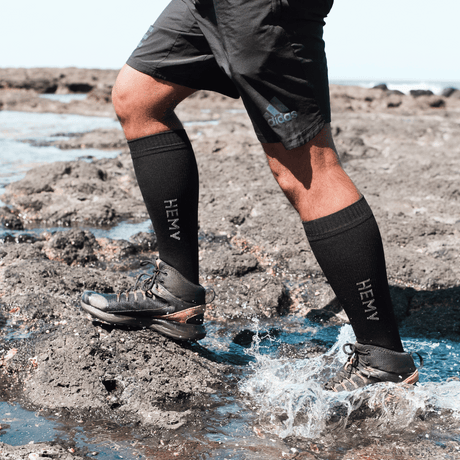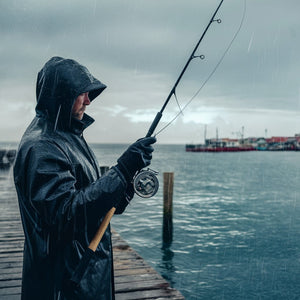Ultimate Guide to the Best Waterproof Gloves for Fishing: Stay Dry While Angling
Jun 14, 2024
1.1 Importance of Waterproof Gloves in Fishing
Protection Against the Elements
Fishing can be a rewarding outdoor activity, but it often exposes you to harsh elements. Waterproof gloves act as a vital barrier against rain, wind, and cold, ensuring hands remain dry and protected. Without them, your hands can quickly become numb, making it difficult to manage gear or enjoy the experience.
Ensuring Comfort and Dexterity
Comfort and dexterity are key when handling your fishing rod, bait, and catches. Waterproof gloves are designed to fit snugly, providing ease of movement that helps you perform intricate tasks without discomfort. The ability to grip, twist, and tie without issues can significantly enhance your fishing experience.
Enhancing Grip and Control
A good pair of waterproof gloves also offers superior grip, even when wet. This is crucial for maintaining control over slippery fish and handling fishing equipment efficiently. Enhanced grip and control not only improve your performance but can also prevent accidents or injuries.
1.2 Factors to Consider When Choosing Waterproof Fishing Gloves
Material and Construction
Opt for gloves made from high-quality, durable materials such as neoprene, rubber, or Gore-Tex. Ensure the gloves have sealed seams to prevent water seepage, which enhances their waterproof capabilities.
Insulation and Comfort
Insulation is crucial, especially for cold-weather fishing. Look for gloves with appropriate insulation levels that balance warmth and thinness so you don’t sacrifice dexterity.
Size and Fit
Choosing the correct size is essential. Ill-fitting gloves can be uncomfortable and restrict movement. Most brands offer sizing charts; use these to measure your hand accurately before purchasing.
1.3 Types of Fishing Gloves: An Overview
Full-Finger Gloves
These offer complete coverage and are ideal for cold conditions or when you need maximum protection. They provide excellent warmth but might slightly reduce dexterity.
Half-Finger Gloves
These gloves leave your fingertips exposed, allowing for higher dexterity. They are suitable for warmer conditions and activities requiring fine motor skills, such as tying knots.
Convertible Gloves
A hybrid option, convertible gloves can switch between full-finger and half-finger styles. They offer the best of both worlds, providing versatility in changing weather conditions.
2. Top Features to Look for in Waterproof Fishing Gloves
2.1 Waterproofing Technology and Materials
Common Waterproof Materials
Neoprene, rubber, and Gore-Tex are popular materials known for their waterproof qualities. Each material has its benefits, with neoprene offering flexibility, rubber being highly durable, and Gore-Tex providing breathability.
Waterproof vs. Water-Resistant
Understand the difference: waterproof gloves offer complete protection against water penetration, whereas water-resistant gloves can only withstand light exposure. For fishing, always opt for waterproof.
Importance of Sealed Seams
Waterproof gloves are only as good as their seams. Sealed seams prevent water from seeping through the stitching, ensuring complete dryness.
2.2 Grip and Dexterity
Different Textures and Patterns
Look for gloves with textured palms and fingers. Patterns such as dots or crisscross designs can provide better grip, especially when handling slippery fish or wet equipment.
Finger Mobility
Flexibility in the fingers is critical. Gloves with articulated or pre-curved fingers offer better mobility, making it easier to perform precise movements.
Reinforced Palms
Reinforced palms add durability and provide extra protection in high-wear areas, helpful when dealing with rough fishing conditions or handling equipment frequently.
2.3 Warmth and Insulation
Types of Insulation Used
Common insulation materials include Thinsulate, fleece, and wool. Thinsulate is known for its warmth-to-thickness ratio, providing excellent insulation without bulk.
Balancing Warmth and Dexterity
Striking a balance between warmth and dexterity can be challenging. Choose gloves that offer adequate insulation without being too bulky, ensuring your fingers can move easily.
Suitable Temperature Ranges
Consider the typical temperatures you'll be fishing in and choose gloves rated for those conditions. Some gloves are designed for extreme cold, while others are more suitable for mild climates.
3. Reviews of the Best Waterproof Gloves for Fishing
3.1 Best Overall Waterproof Fishing Gloves
Top Pick
-
Hemy Waterproof Gloves
Key Features
- Full waterproof protection with sealed seams
- High dexterity and grip
- Suitable for various fishing conditions
Pros and Cons
- Pros: Durable, versatile, excellent insulation
- Cons: Higher price point, may not fit all hand sizes perfectly
4. Maintaining and Caring for Your Waterproof Fishing Gloves
4.1 Cleaning and Drying Techniques
Handwashing Tips
Handwash your gloves with mild detergent to avoid damaging the waterproof materials. Rinse thoroughly to remove all soap.
Machine Washing: Yes or No?
While some gloves may be machine washable, it's generally safer to handwash to maintain the waterproofing and material integrity.
Proper Drying Methods
Air dry your gloves away from direct sunlight or heat sources to prevent material degradation.
4.2 Storing Your Gloves
Avoiding Moisture and Mildew
Ensure your gloves are completely dry before storing them. Moisture can lead to mildew and damage the material.
Using Protective Cases or Bags
Consider using protective cases or bags to store your gloves. This prevents accidental tears and keeps them clean and dry.
Storage Locations
Store your gloves in a cool, dry place. Avoid damp areas like basements or attics to prolong the material's lifespan.
4.3 Repairing and Extending Glove Lifespan
Fixing Minor Tears and Holes
Use waterproof tape or specialized repair kits to mend small tears and holes. This can extend the life of your gloves without compromising waterproofing.
Re-waterproofing Treatments
Over time, gloves can lose their waterproofing. Re-waterproofing sprays and treatments can rejuvenate their protective qualities.
When to Replace Your Gloves
Replace your gloves when they become too worn, lose their insulation capabilities, or can no longer maintain waterproof integrity.
5. User Testimonials and Experiences
5.1 Interviews with Avid Anglers
Inspiring Stories
"I've been using waterproof gloves for years, and they’ve made my fishing trips so much more enjoyable. No more freezing fingers!" - John, avid angler
Favorite Glove Brands
"For me, Simms gloves never disappoint. They offer the perfect balance of warmth and functionality." - Sarah, weekend fisherman
Tips and Tricks
"Always keep a spare pair of gloves in your tackle box. You never know when you might need them." - Mike, fishing guide
5.2 Common Challenges and How to Overcome Them
Dealing with Cold and Wet Conditions
Layering gloves or using hand warmers can make a significant difference in extremely cold conditions.
Handling Fish with Gloves On
Choose gloves with excellent grip and dexterity, ensuring you can handle fish without them slipping.
Balancing Comfort and Performance
Don't sacrifice comfort for performance or vice versa. Test different gloves to find the perfect balance.
5.3 Glove Recommendations for Different Fishing Environments
Freshwater Fishing
Opt for lightweight, flexible gloves that provide enough warmth and waterproofing for varying conditions.
Saltwater Fishing
Saltwater calls for durable gloves with reinforced palms to handle the corrosive environment and larger fish.
Ice Fishing
Thickly insulated gloves are essential for ice fishing. Ensure they offer good flexibility despite the heavy insulation.
6. Conclusion and FAQs
6.1 Summary of Key Points
Recap of Important Features
-
Waterproofing technology and materials
-
Grip and dexterity
-
Warmth and insulation
-
Proper fit and size
Highlighted Top Picks
-
Best Overall: Glacier Glove Alaska River Series
-
Best Budget-Friendly: KastKing Mountain Mist Fishing Gloves
-
Best High-End: Patagonia R1 Fishing Gloves
6.2 Frequently Asked Questions
How Do I Know Which Size is Right for Me?
Measure your hand's circumference and consult sizing charts provided by manufacturers.
Can I Use Waterproof Fishing Gloves for Other Activities?
Yes, they can be used for various outdoor activities like kayaking, hiking, and even snow sports.
What Should I Do if My Gloves Get Damaged?
Minor repairs can be done with waterproof tape or repair kits; for severe damage, consider replacing the gloves.
6.3 Final Thoughts
Choosing the right waterproof fishing gloves can make a huge difference in your angling experience. Take the time to find the pair that suits your needs, and don't be afraid to try out different options. The right gear will ensure you stay dry, comfortable, and in control, allowing you to focus on the thrill of the catch!



